CHAPTER 4
Shovelling and Adaptation
|
In the two preceding chapters shovelling was considered to be a structure for strengthening the incisor in a different way from the lingual tubercle, able to vary in response to certain adaptive demands independently of the variation in the overall dentition or in the posterior teeth. In the present chapter, the variation in frequency of shovelling in world populations will be investigated through the literature to make the adaptive significance of shovelling clearer. Riesenfeld (1956) found a tendency for shovelling to decrease in frequency from west to east in Oceania and interpreted it as a trace of the Mongoloid migration from west to east. It is certainly known that the degree of development of shovelling can be changed by admixture (Hanihara, 1968). However, what does the cline in frequency of shovelling from north to south in China (Lasker, 1945) mean? How should we interpret the fact that Eskimos and Aleuts living in the Arctic have extremely-developed shovelling (
|
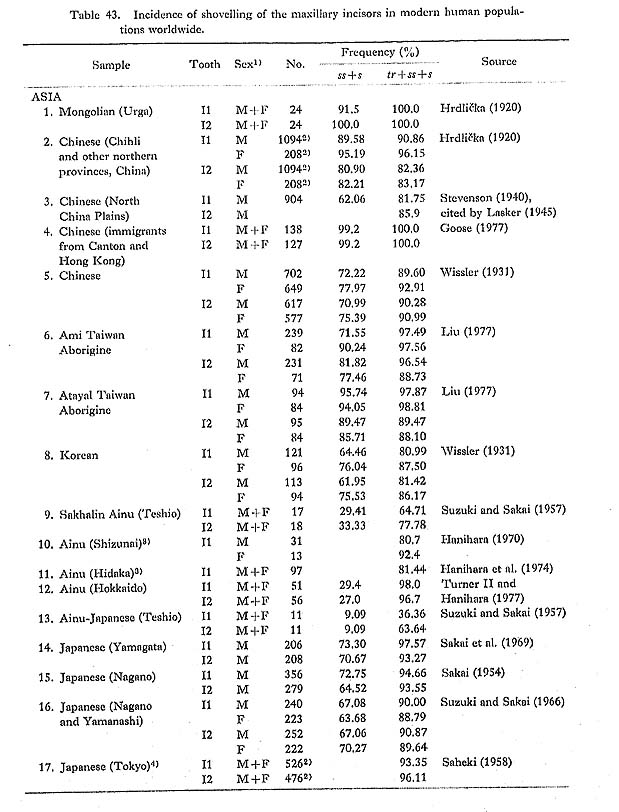 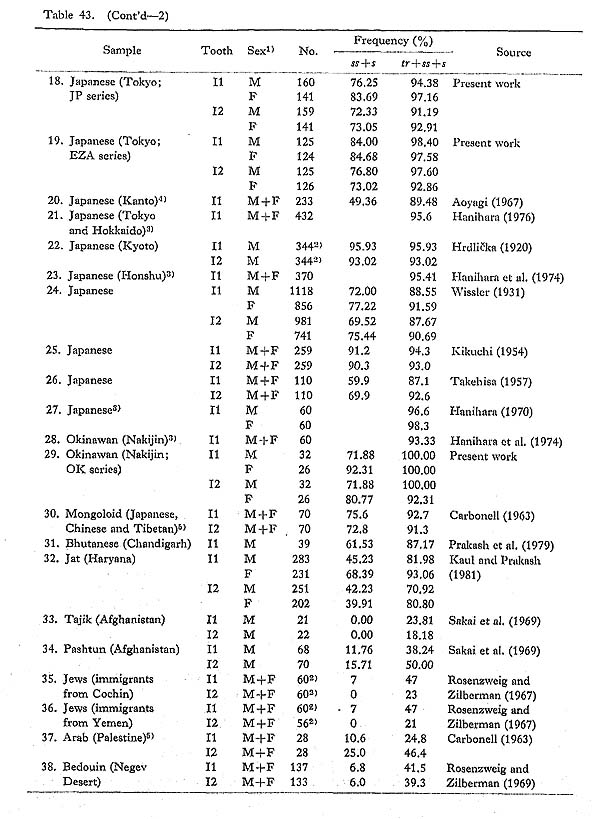 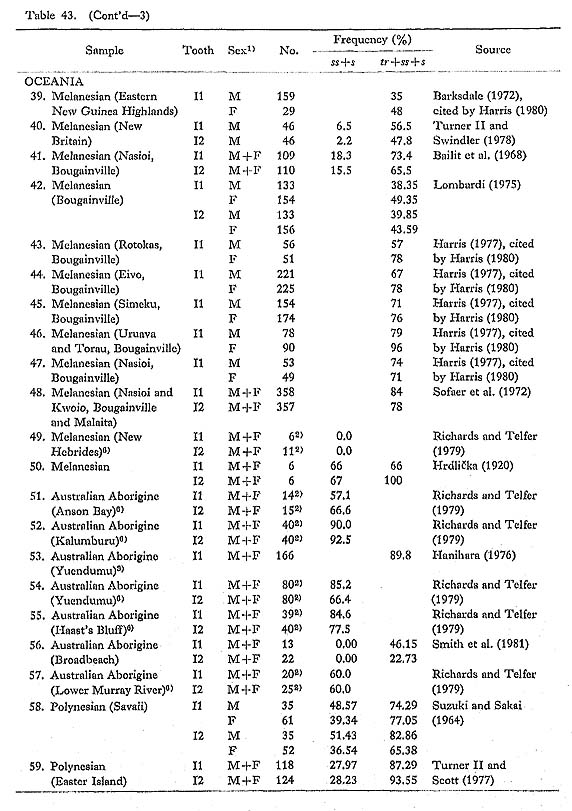 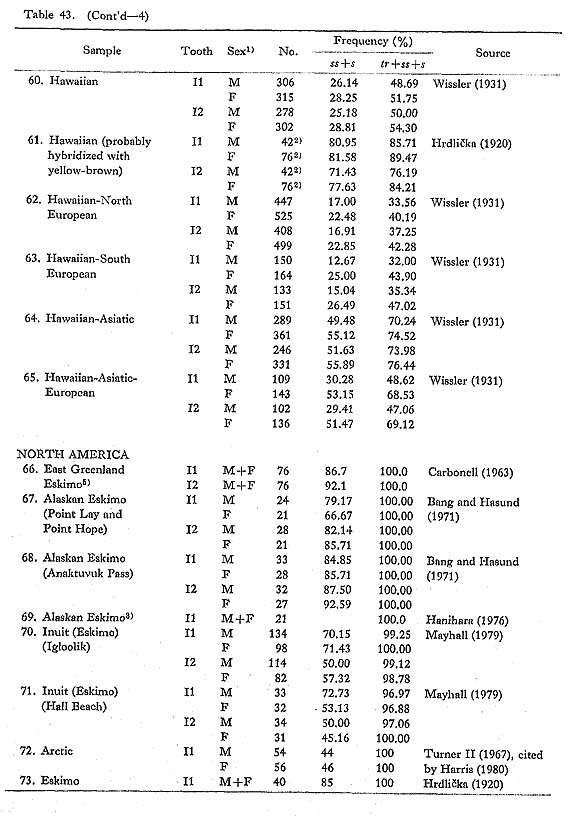 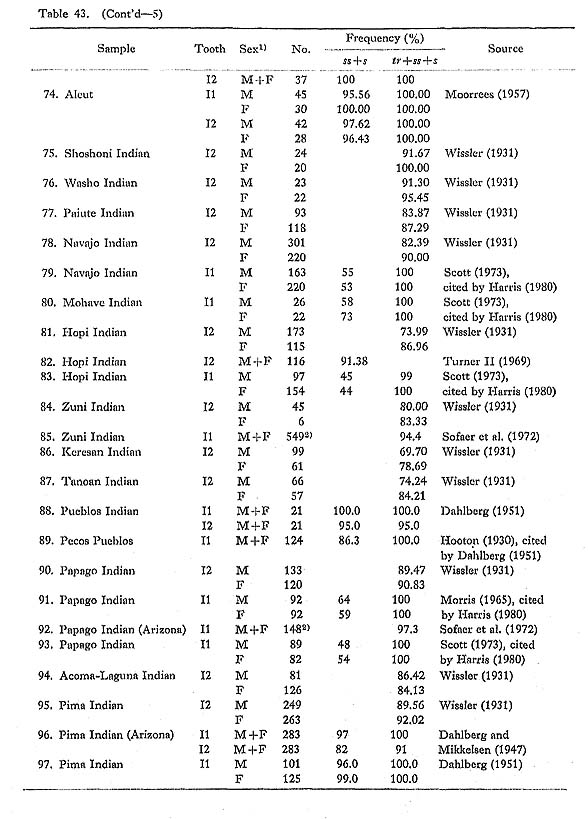 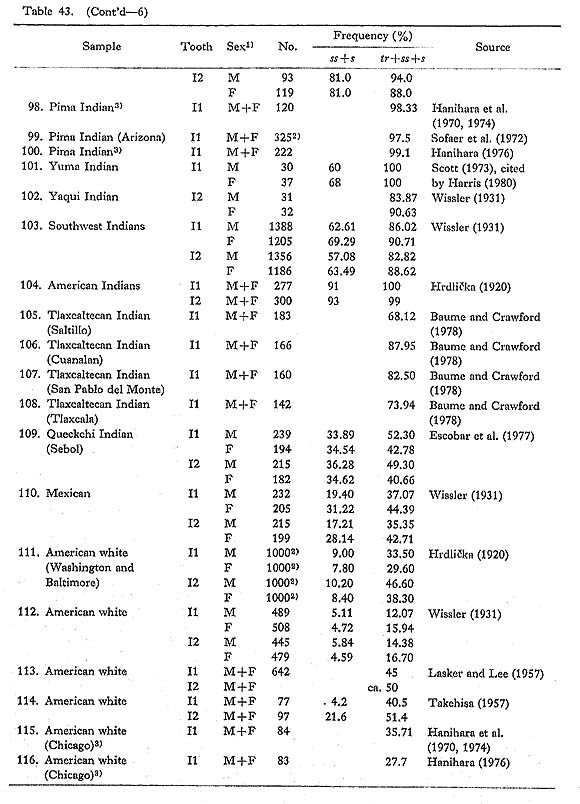 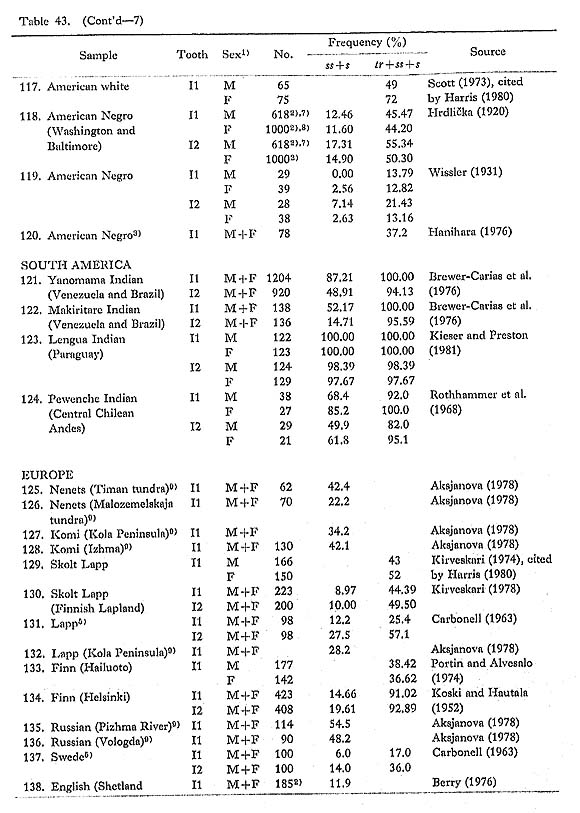  |
 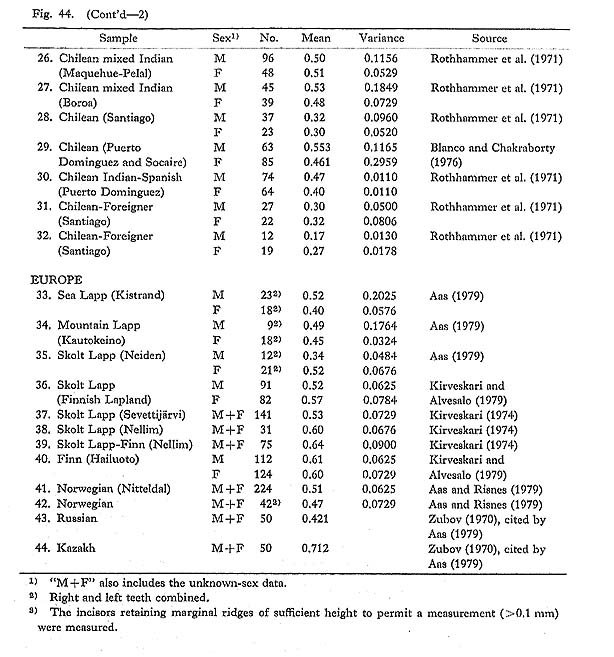 |
The analysis was carried out as follows.
The data from the 148 samples from the literature naturally includes some interobserver errors. In order to assess such errors, χ2-tests were done, First, five Japanese samples examined by different investigators were selected. Second, the shovelling data, which was represented by the four expressivities, was grouped into two grades, or transformed to all-or-none or presence-or-absence data, in three ways: "s" or "ss+s" or "tr+ss+s" was regarded as "presence." Finally, under the assumption that the Japanese population was homogeneous, the best classification for minimizing the differences between the above five samples was determined by χ2-tests of the three classifications.
Based on this, the frequencies in the 148 samples were recalculated by the present author, then the samples which seemed to belong to the same population were combined to make up a new group in order to obtain a value as typical of the relevant population as possible. The statistic used for representing a newly composed group was the median. The number of such new groups was 26, and their median values are shown in Table 45. In this table, a few somatological measurements as well as data on some climatic factors and lifeways are also shown, all of which were again derived from the literature. The variables adopted here are as follows:
- Somatological measurements; stature, cephalic index and nasal index.
- Latitude.
- Climatic factors: average annual temperature, average temperature in the hottest month, average temperature in the coldest month, mean relative annual humidity and amount of annual rainfall.
- Way of life in about the 15th century: hunting-gathering, cattle breeding, milking and agriculture.
  |
Of the above, variables 1) to 3) are continuous, but those of 4) are dichotomous, taking a value of "1" or "0" for each way of life adopted or not. The sources of these data are listed in Tables 45-1 and 45-2. For each item 1) to 3), a median value for each population was calculated on the basis of available values. The ways of life in 4) were classified by the present author on the basis of maps which Ishige (1973) drew, illustrating our conceptions of 15th century conditions before the discovery of the New World.
  |
The associations between these variables were evaluated by Spearman's and Kendall's rank correlation coefficients (Siegel, 1956), Yule's coefficient of association and the four fold point correlation coefficient (Yasuda, 1969). The former two were used for esti mating associations between the variables of 1) to 3) above and shovelling, and the latter two for the dichotomous variables. In using the latter coefficients, the frequencies of shovelling, average temperatures, etc. were each transformed into all-or-none data on the basis of the median value of the 26 groups, resulting in the score for a group being "1" when the original value was greater than this median value or "0" when it was smaller.
Rank correlation coefficients of the two sorts were calculated with the RKCNCT program, and the coefficients of association of two sorts for dichotomous variables with the CNDSFQ program. These programs were written in FORTRAN by the present author. In the RKCNCT program, however, the subroutine sub-program NORMAL (Hanihara, 1974) was utilized.
4.2. Results
Most of the shovelling data had been compiled by previous authors using the four exprcssivities denned by  (1920). First, the place most suitable for a dividing plane was sought between the four expressivities in order to minimize the errors in observation when this data was transformed into dichotomous data. As regards the intra-observer errors of the present author himself (Table 41), the discordance frequency between the double observations of the same subjects was lowest in the classification of "no+tr" and "ss+s," i.e., 3.51%. However, there was no significant difference between the error discordances in the three ways of classification at the 5% level, and, especially, there was no great difference in error even if either of "ss+s" and "tr+ss+s" was regarded as "presence."
(1920). First, the place most suitable for a dividing plane was sought between the four expressivities in order to minimize the errors in observation when this data was transformed into dichotomous data. As regards the intra-observer errors of the present author himself (Table 41), the discordance frequency between the double observations of the same subjects was lowest in the classification of "no+tr" and "ss+s," i.e., 3.51%. However, there was no significant difference between the error discordances in the three ways of classification at the 5% level, and, especially, there was no great difference in error even if either of "ss+s" and "tr+ss+s" was regarded as "presence."

To assess the inter-observer errors for shovelling, only samples from the Japanese population were used. As shown in Table 42, it was recognized that there were sig nificant inter-observer differences in all the dichotomous classifications. Of the three ways of classification, however, the classification regarding "tr+ss+s" as "presence" had the smallest between-sample difference. Therefore, this dichotomous classification was adopted here. However, since Dahlberg (1951) stated that the data of "ss+s" would be more reliable when comparing certain frequencies of shovelling with others, many authors have followed him. Some authors have reported only the data for "ss+s." Accordingly, the frequencies of both "ss+s" and "tr+ss+s" are shown in Table 43.
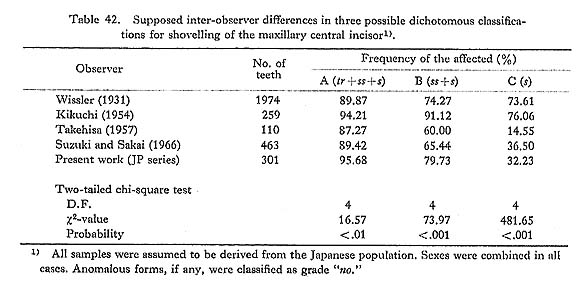
After the 148 samples collected from the literature were recombined into 26 groups, median values throughout such groups were also estimated (Table 45). These median values suggest that the incidence of shovelling generally tends to be higher in females than in males, but the incidence does not differ so much between the central and the lateral incisors.
The rank correlation coefficients of shovelling (tr+ss+s) with climatic factors, somato logical measurements, etc. are shown in Table 46. Spearman's rank correlation coeffi cient (ρ) between the central and lateral incisors was 0.91, and Kendall's (τ) was 0.77. Those which had significant associations (10% level) with shovelling of the central incisor were latitude alone in τ, with the estimate being 0.27. Shovelling of the lateral incisor had significant associations with latitude (ρ=0.43, τ=0.30), the average annual temperature (ρ=-0.42, τ=-0.28) and the average temperature in the coldest month (ρ=-0.41, τ=-0,27). Also in the case of the central incisor, the same items as those of the lateral incisor had relatively high associations with shovelling, though not statistically significant.

Table 47 shows the estimated associations between shovelling and environmental factors including ways of life. In this case, Yule's coefficient of association (Q) and the four-fold point correlation coefficient (Υ) were used for estimating such associations, but significance tests for them were not carried out. The strong association between shovelling of the central incisor and of the lateral one was recognized this time as well. By tentatively selecting the items which had an association of more than 0.50 in the absolute value of Q or of more than 0.25 in the absolute value of Υ and trying to find any tendencies, they were found to be as follows.

The items associated strongly with shovelling of the central incisor are stature (Q=-0.61, Υ=-0.32), latitude (Q=0.52, Υ=0.28), average annual temperature (Q=-0.52, Υ=-0.28), average temperature in the coldest month (Q=-0.52, Υ=-0.28) and milk ing (Q=-0.63, Υ=-0.32). Those which were strongly associated with shovelling of the lateral incisor are stature (Q=-0.70, Υ=-0.39), latitude (Q=0.65, Υ=0.37), average annual temperature (Q=-0.65, Υ=-0.37), average temperature in the coldest month (Q=-0.65, Υ=-0.37), amount of annual rainfall (Q=0.50, Υ=0.27) and milking (Q=-0.83, Υ=-0.47).
For reference, the items associated with stature, cephalic index and nasal index will also be described here. Since there are some data on these reported by previous authors, the feasibility of the method adopted in the present study can be assessed based on them, though indirectly. The items which had significant rank correlation coefficients (10% level) with these somatological measurements are as follows. First, there were no items significantly associated with stature. The items associated with cephalic index are nasal index (ρ=-0.36, τ=-0.28), average annual temperature (ρ=-0.39, τ=-0.26) and average temperature in the hottest month (ρ=-0.47, τ=-0.34). Those which were associated with nasal index are latitude (ρ=-0.46, τ=-0.35), average temperature in the coldest month (ρ=0.40, τ=0.29) and amount of annual rainfall (ρ =0.54, τ =0.43).
4.3. Discussion
The associations between shovelling and several climatic factors, ways of life, etc. were investigated here. Before discussing such associations, however, there are a few points to be examined.
Most investigators have analyzed shovelling by adhering to  's (1920) classi fication criteria. However, systematic errors due to different observers cannot be avoided even if the same criteria are used. Dahlberg (1951) stated that combining "ss" and "s" would be a better method to use when data collected by different authors were com pared with one another. Suzuki and Sakai (1966) and others adopted this advice. Al though this problem cannot be resolved simply because the development of shovelling differs in degree from population to population, the classification which regards "tr+ ss+s" as shovelling seems to be the best one, at least for the Japanese population, as shown in the preceding section. Turner and Hanihara (1977) also examined the inter observer error between the two authors, who observed different samples from the same population. Their result was that there was no significant inter-observer error at the 5% level when five of the seven grades in their classification were regarded as "presence." The sum of these five grades seems almost consistent with "tr+ss+s."
's (1920) classi fication criteria. However, systematic errors due to different observers cannot be avoided even if the same criteria are used. Dahlberg (1951) stated that combining "ss" and "s" would be a better method to use when data collected by different authors were com pared with one another. Suzuki and Sakai (1966) and others adopted this advice. Al though this problem cannot be resolved simply because the development of shovelling differs in degree from population to population, the classification which regards "tr+ ss+s" as shovelling seems to be the best one, at least for the Japanese population, as shown in the preceding section. Turner and Hanihara (1977) also examined the inter observer error between the two authors, who observed different samples from the same population. Their result was that there was no significant inter-observer error at the 5% level when five of the seven grades in their classification were regarded as "presence." The sum of these five grades seems almost consistent with "tr+ss+s."
Whether there is any between-sex difference in the frequency of shovelling has been debated for a long time. Recently Harris (1980) collected data from the literature on the frequencies of shovelling of the central incisor in 38 samples from various world popula tions. He combined these samples to make up six new groups of Caucasians, American Negroes, Asians, Polynesians, Melanesians and American Indians, and examined the presence or absence of the between-sex difference in each group. In conclusion, he stated that shovelling was more frequent in females than in males in all the groups but American Negroes. In the individual samples recorded previously, however, there were varying cases, i.e., the frequency of shovelling was higher in males in some cases, lower in some cases or nearly the same in males and females in other cases (Table 43). In the present samples, the JP and EZA series, there was no significant between-sex difference in the central incisor nor in the lateral one (Table 2). Nevertheless, taking a look at the median values of world populations, it seems certain that shovelling is more frequent in females than in males in both the case of the central and lateral incisors (Table 45), as reported by Harris (1980). However, it should be noted that this might be caused secondarily merely by the presence of the sex differences in the mesiodistal diameters of the incisor crowns, as Hanihara (1954) suggested that the difference in frequency of shovelling between the central and the lateral incisors might be due to the differ ence between the mesiodistal sizes of their tooth crowns. Regarding this problem, there is great room for future examination.
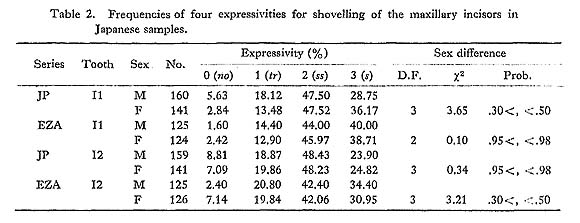
Before discussing the associations of shovelling with climatic factors and others, we need to examine further to what extent the method employed here is reliable.
To begin with, the climatic factors which had significant rank correlation coefficients (10% level) with the cephalic index were the average annual temperature and the average temperature in the hottest month. These correlations were negative, implying a tendency for the proportion of longheaded people to be higher in hotter regions and for short headed people to be more numerous in colder regions. This is quite consistent with the results obtained by Beals (1972) using another method, and also not inconsistent with the findings by Guglielmino-Matessi et al. (1979) that cranial breadth tends to be greater in cold regions.
The items which were found to be significantly (10% level) associated with nasal index, similarly by rank correlation coefficients, were latitude, the average temperature in the coldest month and the amount of annual rainfall. The former one was negative, and the latter two were positive. This implies that a relatively narrow nasal breadth is more frequently found in the higher latitudes of the Northern and Southern hemi spheres, or in the regions where the average temperature in the coldest month in a year is lower or where the amount of annual rainfall is less. Yamaguchi (1970) appreciated Newman's finding that the nasal indices of American Indians were smaller in higher latitudes. According to Carey and Steegmann (1981), Weiner observed a correlation coefficient between nasal index and absolute humidity as high as 0.82, and four other authors reported that the nasal index was closely related to temperature and relative humidity. Based on these reports, Carey and Steegmann (1981) concluded that relatively narrow noses were more frequent in cold and, particularly, dry regions. This is again compatible with the results in the present study. Further, Carey and Steegmann (1981) stated that the measure of cold is seemingly more important for the morphology of the nose than that of warmth. Wolpoff (1968) showed, based on six samples from Alaskan Eskimo and Australian aboriginal populations, that the nasal breadth was smaller in colder and drier regions. These findings are also not inconsistent with the results of the present study.
We found that the method used in the present study is never unreliable. It is further noted that not only the rank correlation coefficients but also the coefficients of associa tion for dichotomous variables showed almost the same tendency in the results. Accord ingly, the results on ways of life for which only dichotomous data were obtained also seem reliable, at least methodologically and apart from the reliability of the data itself. Following, then, is a discussion of the results of the shovelling analysis obtained by this method.
Shovelling of both central and lateral incisors had nearly the same tendency, though they were slightly different in degree, for a positive association with latitude as well as negative associations with the average annual temperature and the average temperature in the coldest month. This tendency can be recognized both in the rank correlation coefficients and in the coefficients of association for dichotomous variables. According only to the latter, shovelling of both central and lateral incisors further had high negative associations with stature and a lifeway that included milking. That is, it is most likely that well-developed shovelling is found more frequently in higher latitudes and in colder regions, as well as in short people with a lifeway that excludes milking. A typical example of this is precisely the condition of the Eskimos. It may also be said that shovel ling is not so developed in tall people with a lifeway that includes milking in hot regions in low latitudes. Apart from the question of whether or not this argument is directly applicable to the condition of early hominids, there do not seem to be docu ments to show that highly developed shovelling was present in Africa from the age of australopithecines up to the present (see 2.4.3.). If so, it is possible to think that in the tropical regions of Africa or the like there has been an environment in which man can live without developing shovelling in his incisors. Then, was the strong development of shovelling also related to any cold environment in the past? It is certain that some Homo erectus or Neanderthals with highly developed shovelling experienced the glacial periods. For the present, however, there does not seem to be enough evidence to argue a causal relation.
In general, the characteristics of Mongoloid skulls, especially the facial flatness, have
been considered to be those which were produced through adaptation to severely cold environments (Coon et al., 1950; Yamaguchi, 1970, 1977; Hylander, 1977). Particularly, the crania of Eskimos have such peculiarities as large spacious orbits, a narrow nasal aperture, reduced nasal bones, increased facial flatness, an enlarged zygomaxillary region, high temporal lines, a shallow glenoid and canine fossa, a robust mandible with a wide, low, oblique ascending ramus, a high incidence of palatal and mandibular tori, increased thickness of the tympanic plate, sagittal keeling, a weakly developed brow, pronounced gonial eversion and a high incidence of third molar agenesis (Hylander, 1977). To explain these characteristics, two major hypotheses have been proposed at present (Hylander, 1977). One is the "cold adaptation hypothesis" by Coon et al. (1950) that postulates that such peculiarities are a result of an adaptation to minimize heat loss in the cold environment of the Arctic. The other is the hypothesis proposed long before by  that it is a structure for resisting powerful biting forces (Hylander, 1977). Hylander (1977) assumed a negative attitude to the former because of the scarcity of evidence favoring it. Instead, he took up a position sustaining
that it is a structure for resisting powerful biting forces (Hylander, 1977). Hylander (1977) assumed a negative attitude to the former because of the scarcity of evidence favoring it. Instead, he took up a position sustaining  's hypothesis and claimed that the peculiar structure of Eskimo skulls was especially adapted to gen erate and dissipate large vertical biting forces. Further, Hylander (1977) asserted that the low prognathism typical of Eskimos could be viewed as an adaptation to reduce the bending moments acting on the facial skeleton in order to dissipate more effectively the excessively large biting forces in the anterior region of the Eskimo skull. Hylander's statement seems useful also for explaining the relation between the structure and func tion of shovelling. In the facial skeleton of the modern Japanese skull, in which shovel ling is not as highly developed as that of Eskimos and the flatness of the zygomaxillary region is extraordinarily weak among Mongoloid populations (Yamaguchi, 1973), it has been demonstrated through biomechanical experiments that the region in which the strain caused by biting forces is greatest is the lower frontal part of the upper jaw (Endo, 1965, 1969). Endo considered that such a facial skeleton was possibly adapted to occlude chiefly using the cheek teeth.
's hypothesis and claimed that the peculiar structure of Eskimo skulls was especially adapted to gen erate and dissipate large vertical biting forces. Further, Hylander (1977) asserted that the low prognathism typical of Eskimos could be viewed as an adaptation to reduce the bending moments acting on the facial skeleton in order to dissipate more effectively the excessively large biting forces in the anterior region of the Eskimo skull. Hylander's statement seems useful also for explaining the relation between the structure and func tion of shovelling. In the facial skeleton of the modern Japanese skull, in which shovel ling is not as highly developed as that of Eskimos and the flatness of the zygomaxillary region is extraordinarily weak among Mongoloid populations (Yamaguchi, 1973), it has been demonstrated through biomechanical experiments that the region in which the strain caused by biting forces is greatest is the lower frontal part of the upper jaw (Endo, 1965, 1969). Endo considered that such a facial skeleton was possibly adapted to occlude chiefly using the cheek teeth.
Taking the above and the conclusions of the two preceding chapters (2. and 3.) together, shovelling should be considered basically as part of the facial structure asso ciated with powerful biting forces.
However, why is the habitat of people with such a facial structure restricted to the severely cold regions at present? If there is any reason why the biomechanically strong structure cannot occur in other than severely cold regions, this facial structure itself should be regarded as part of adaptation to the cold.
As was stated previously, well-developed shovelling is less frequent in populations whose lifeways include milking. Having a lifeway that includes milking implies that a stable source of nutrition is maintained. Therefore, neither the teeth as a tool nor the teeth as a chewing apparatus for a great deal of food need to be so well developed. This may be considered as a cause for shovelling not to develop. On the other hand, however, all hunter-gatherers who always pursue food-gathering activities do not necessarily have well-developed shovelling (Table 47). But this may be said to be natural. Consider ing the food habits of hunter-gatherers, it is known that there is a variety, from vegetarian to meat-eating, corresponding to the gradual change of climatic zones from the tropical to the polar regions (Lee, 1968; Watanabe, 1978). Watanabe (1978) stated that while the main foods of northern hunter-gatherers were animals, those of the hunter-gatherers living in the tropical islands of Southeast Asia or the like were vegetables, the latter seeming to be typical of the oldest stage in the evolution of human food habits. He furthermore proposed the hypothesis that while evolving hominids migrated and dif fused from the tropical to the polar regions, an adaptive radiation of food habits occurred from vegetarianism to meat-eating. The above fact and hypothesis are very suggestive for understanding the geographical variation and the temporal change in shovelling. As was already stated, highly developed shovelling has not been found in Africa since the australopithecine stage, but modern Eskimos and others in severely cold regions have extremely-developed shovelling. Supposing that the development of shovelling is not influenced by merely adopting the lifeway of hunting-gathering but by the weight of hunting or meat-eating in that lifeway, the superficial relationship observed betweenshovelling and latitude or temperature may be understood. If so, the strongly developed shovelling seen in Peking man and European Neanderthals may also indicate their active hunting life.
In the above, the problem of which adaptive demand shovelling occurred as a re sponse to was discussed. The conclusions drawn are as follows. First, shovelling is primarily part of the facial structure resisting powerful biting forces, and, second, one of the causes by which such a structure is generated seems to be hunting activity directly or indirectly associated with heavy meat-eating.
However, it goes without saying that these hypotheses should be examined in more detail in future. To consider the significance of the existence of shovelling, the mechani cal structure of a shovel-shaped tooth itself, its relation to the morphology of the facial skeleton, its relations with dental attrition and the manner of using teeth in modern and fossil hominids, the relations between languages and anterior teeth, etc. appear to be of particular importance.
The question that was the starting point of this study, of why shovelling is peculiarly frequent in Mongoloids seems, after all, to be a problem which should be solved only by tracing the history of adaptation of the Mongoloid population.
4.4. Summary
The adaptive significance of shovelling was discussed based on associations between shovelling and some climatic factors, ways of life, etc.
First, the incidence of shovelling in 148 samples of modern man from various regions in the world were collected from the literature. Based on these, it was found by using coefficients of association of four sorts that there were positive or negative associations between shovelling and the latitude, average annual temperature, average temperature in the coldest month, a lifeway which included milking, etc.
Taking these results and previous studies on the facial structure of the Eskimo skull and the food habits of hunter-gatherers into account as a whole, it was inferred that shovelling was primarily part of the facial structure resisting powerful biting forces, and one of the causes of the need for such a powerful biting mechanism was possibly hunting activity directly or indirectly associated with heavy meat-eating.